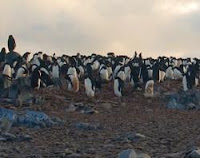 The extent to which humans have managed to poison the planet is scary. In the latest case, the pesticide DDT has been found in Adélie penguins in Antarctica, a place where DDT was never sprayed.
The extent to which humans have managed to poison the planet is scary. In the latest case, the pesticide DDT has been found in Adélie penguins in Antarctica, a place where DDT was never sprayed.
A 1964 survey found modest amounts of the pesticide in Adélie penguins, and Geisz's team expected to see even less four decades later. Instead, her team found DDT levels unchanged in birds that live near the continent's western peninsula.The levels of DDT and DDE present in the Adélie penguins are too low to cause much harm. However, the findings indicate the presence of other harmful chemicals being released as the glaciers melt. The Arctic and Antarctic are visibly pristine landscapes, but the pollutants we release in warmer regions all migrate there eventually.
As DDT crawls up the food chain, from plankton to krill to penguins, it breaks down into a sister molecule called DDE. The more DDE in an animal, the longer the chemical has been around, Geisz says. But her team recorded low levels of DDE in the birds, suggesting a fresh source.
Geisz couldn't figure out where the DDT came from until she looked back at glacial records. In the 1950s and 60s, Antarctic glaciers swelled, potentially locking in chemicals like DDT.
However, average winter temperatures on the Antarctic Peninsula have warmed 6 °C the past 30 years, and glaciers now melt faster than they grow. A recent study noted elevated levels of DDT in glacial runoff.
As the continent's western ice sheet melts, the DDT drips back into the ecosystem at a rate of 1 to 4 kg per year, her team estimates.



